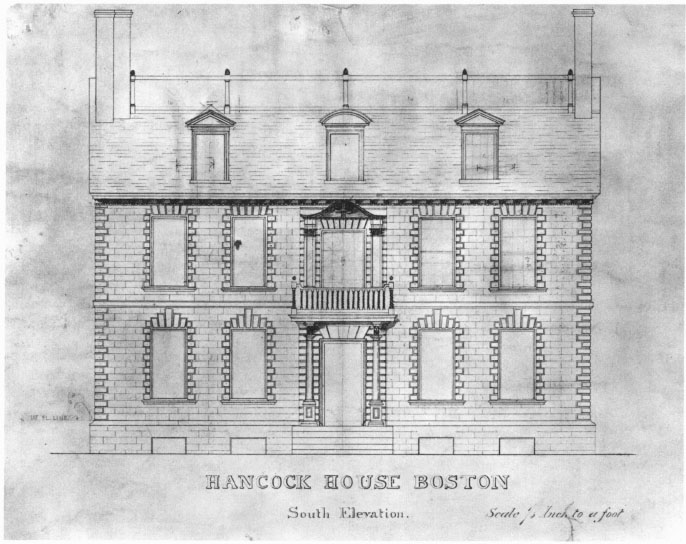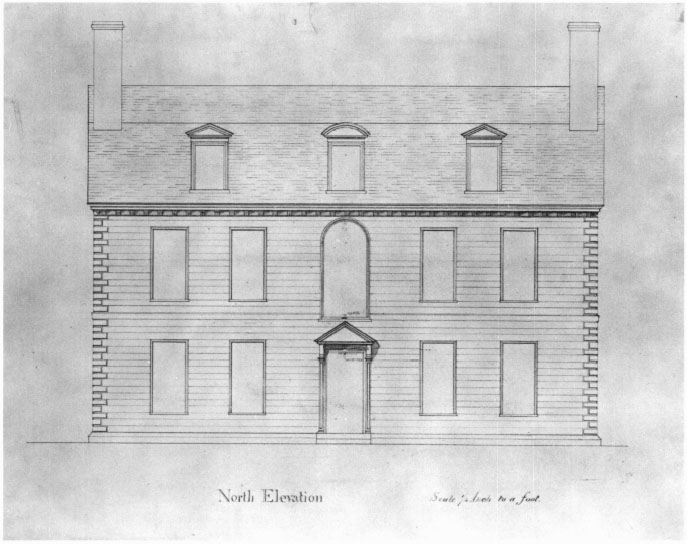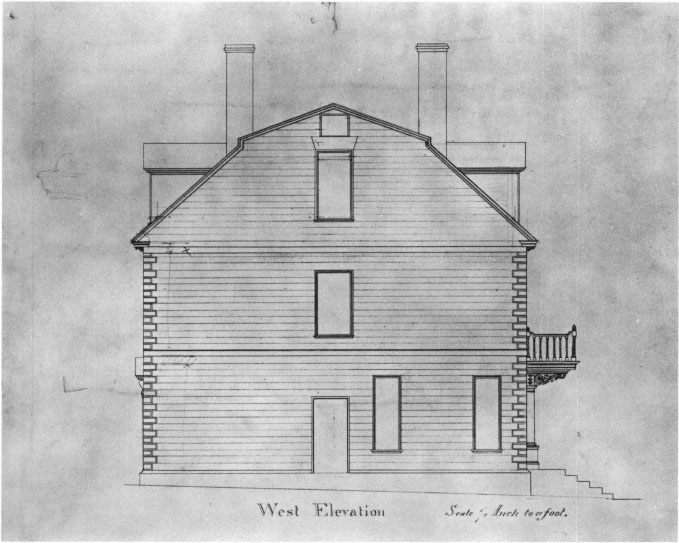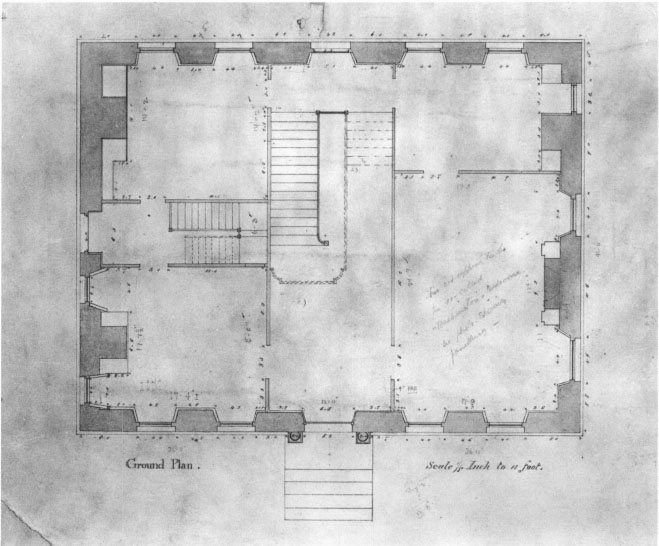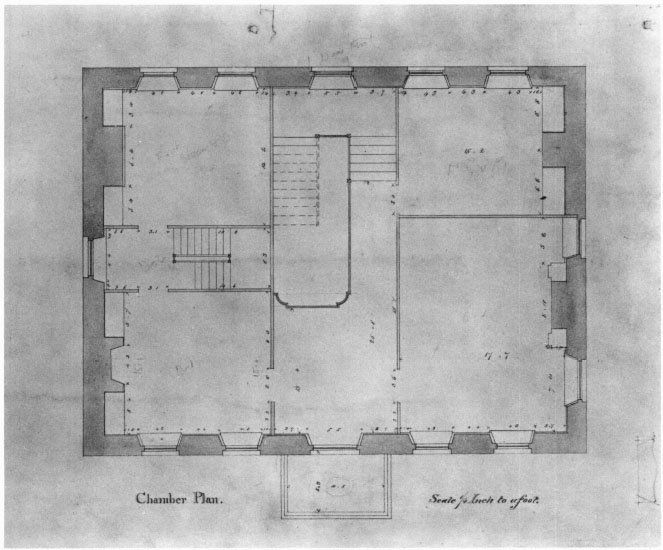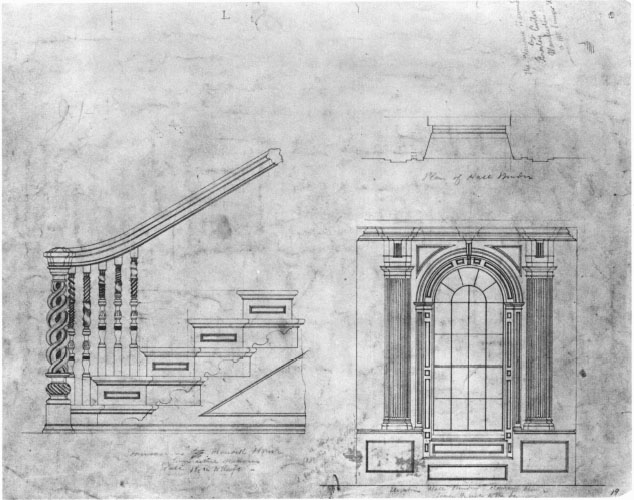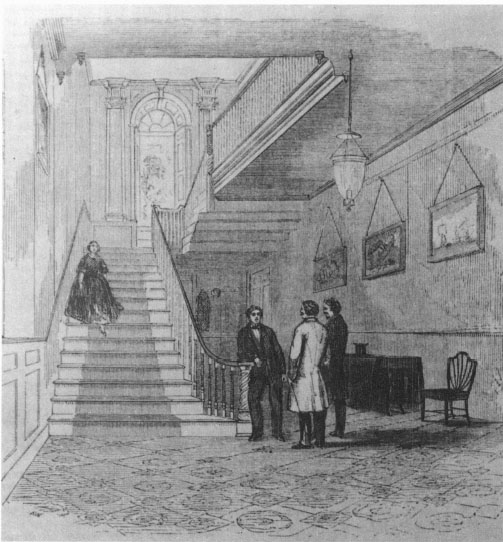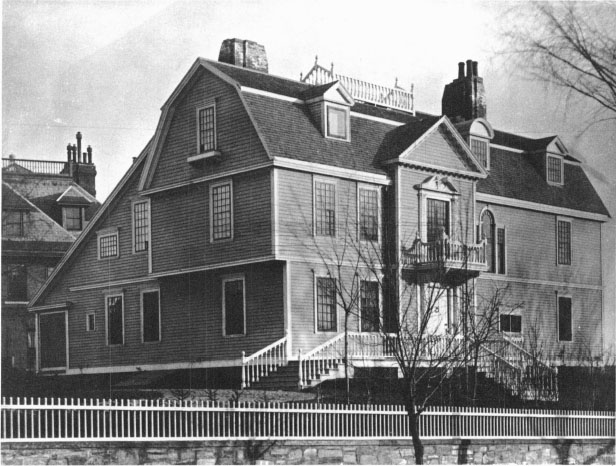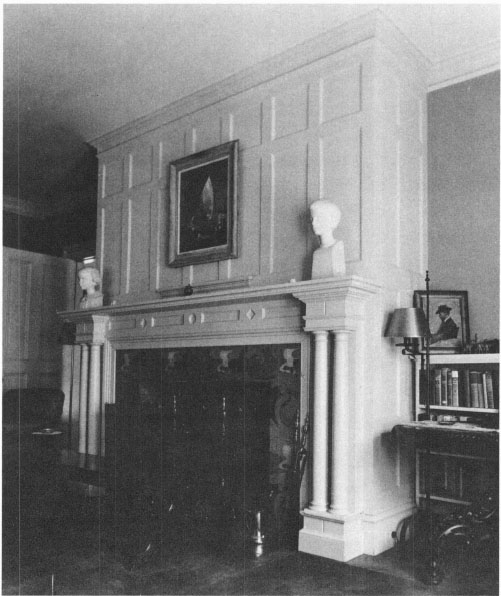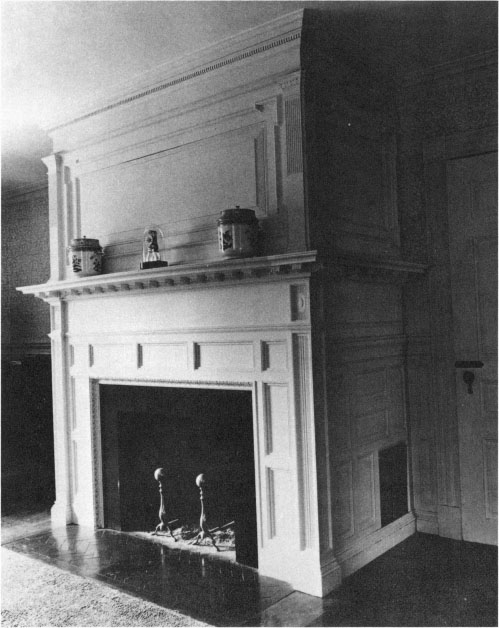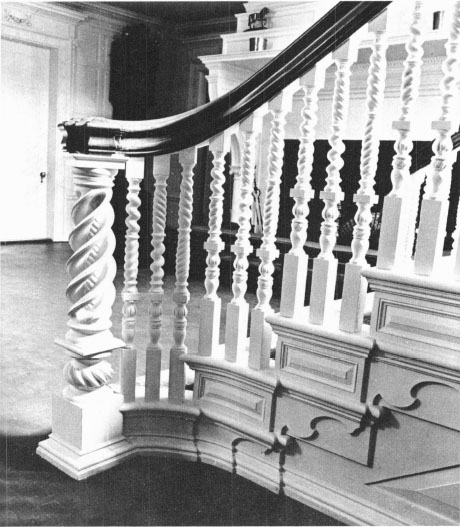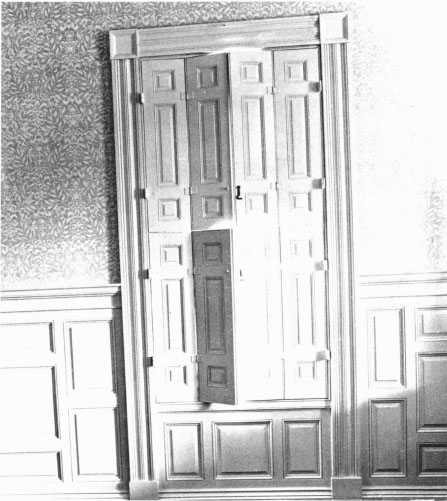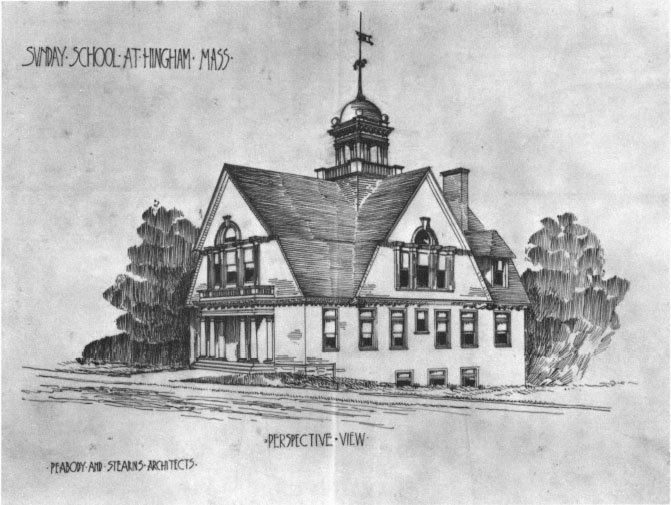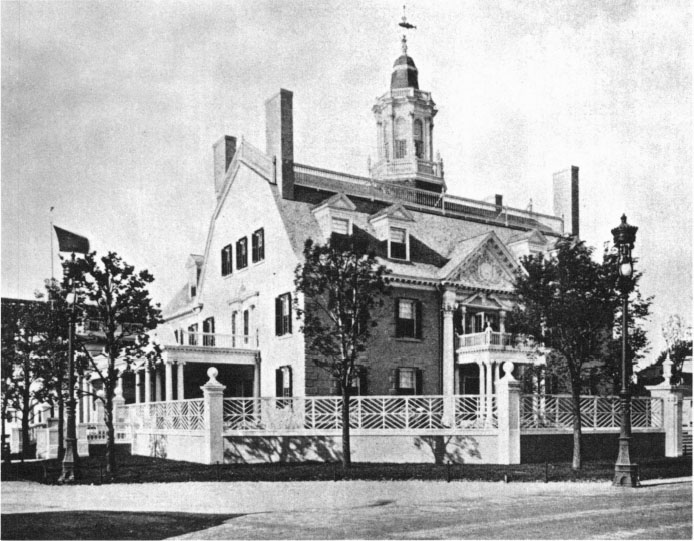Measured Drawings of the Hancock House by John Hubbard Sturgis: A Legacy to the Colonial Revival
ONE of the first great battles for historic preservation was waged over the Hancock House on Beacon Street in Boston in 1863 (Fig. 24). Was the one-hundred-and-twenty-six-year-old stone mansion, home of the first governor of the Commonwealth, to be destroyed or preserved? The matter of the Hancock House came to a head during the Civil War, and with public attention divided between battles on the field and battles in the legislature, historic preservation would appear to have lost the first skirmish. A fire-engine-red six-foot-high auctioneer’s poster (now in the library of the Society for the Preservation of New England Antiquities) advertised sale of interior details and stone from the Old Hancock House at 4 p.m. on the premises, June 26, 1863.62 Massachusetts mourned the day, wrote Franklin Webster Smith, when a narrow-minded legislature refused to buy and save the home of John Hancock for a gubernatorial mansion.63
Within these events lies an even more fascinating story—that of the staircase from the house, which was preserved and re-used along with numerous other bits and pieces of the fabric, now widely scattered.64 Measured drawings made of this staircase, and in fact of the entire building prior to its demolition, are now in the collections of the Society for the Preservation of New England Antiquities, being the first known full set of measured drawings to have been made of an American house.
The seven known drawings of the Hancock House, executed by the young architect John Hubbard Sturgis (1834–1888) just prior to its demolition in 1863, may well have been part of a larger series. Scaled at ¼″ to a foot are all four elevations (Figs. 25–28) and the full ground and chamber floor plans (Figs. 29 and 30). A final drawing at 1½″ to a foot, the only one of the interior, shows details of the staircase and hall window (Fig. 31). Measured drawings are an essential process in historic preservation.65 In the case of the Hancock House, these staircase drawings were a specific legacy to later houses of the Colonial Revival period of the late nineteenth century.
One of the most extensively documented of all Colonial buildings, the stone mansion of Thomas Hancock, wealthy Boston merchant, had been painstakingly constructed beginning in 1736. Many parts of the house were imported from England: the caps for four pilasters, glass for the windows, wallpaper, and many of the furnishings.
Arthur Gilman of Bryant and Gilman (largest architectural firm in the city) went through the documents concerning the house and wrote up its history for the Atlantic Monthly in 1863.66 By this time the outstanding architectural merits of the building were reinforced by its patriotic and historic associations and its antiquity.
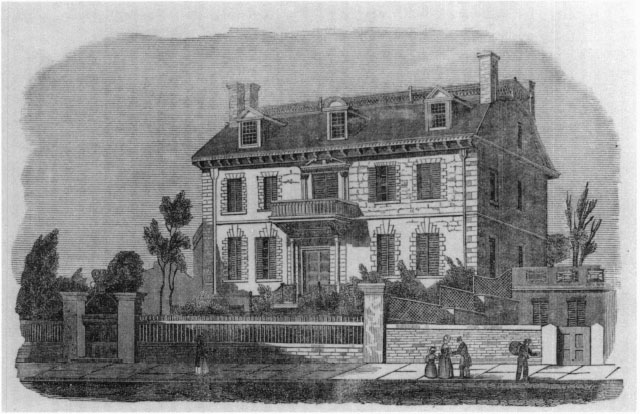
24. Residence of John Hancock, Boston, Mass. Woodcut from Sears Pictorial History of the United States (1848).
[The house] was thought to be a very grand and famous affair in the infant metropolis of New England in the year 1737 . . . [but] it is now the sole relic of the family mansions of the old Town of Boston, as in many respects it has long been the most notable and interesting of them all. . . . We enter the close front-gate from the sunny and bustling promenade of Beacon Street, pass up the worn gray terrace of steps, and in a moment more closes behind us the door that seems to shut us out from the whirl and turmoil and strife of the present, and, almost mysteriously, to transport us to the grave shadows and the dignified silence of the past of American history.67
The central block of the house was a rectangle fifty-six feet in length and thirty-eight feet deep. The walls were of squared granite ashlar from Medford with rusticated quoins and window dressings of Connecticut brownstone ornamenting the symmetrical facade.68 Two large wings, a ballroom to the east and kitchen and offices to the west, were gone by 1863. The date of these wings (Fig. 32) is unknown, but construction took place between 1737 and July of 1789, when Hill illustrated them in an engraving in the Massachusetts Magazine. Sturgis’ measured drawings strongly suggest that these wings were not structurally original to the house. The thickness of the end walls (Fig. 27) indicates that they must have been intended as part of the exterior fabric, while the belt course between stories and at the eaves continues uninterrupted across the east and west elevations (Figs. 29 and 30). The east wing was removed in 1818 and both by 1848 (Fig. 24).
The double pitched gambrel roof had carved modillions at the cornice, a railing at the top, and three pedimented dormer windows, the central one arched in fine Baroque form. Below, the entrance was approached by a flight of stone steps. Rusticated from sill to eaves, it boasted ornate engaged columns, an ornamented door head with an elaborate balcony and a large window above, complete with broken scroll pediment (Fig. 25).
The plan of the interior was a typical one for a great mid-century house, dominated by a staircase hall bisecting the building from front to back on both floors (Fig. 33). Above the landing was an arched window with deep reveals flanked by classical pilasters. The staircase itself had variously carved and twisted balusters and newel (Fig. 31). The Washington bedroom, 17ʹ7ʺ × 21ʹ10ʺ, was located at the southeastern corner of the second floor, facing on Beacon Street (Fig. 34). The elaborate chimney breast, which jutted into the room from the east, was adorned with fluted Corinthian pilasters, more ornate than those on the stair landing. The great room was richly furnished and architecturally advanced for 1737, with panelling from floor to ceiling.69
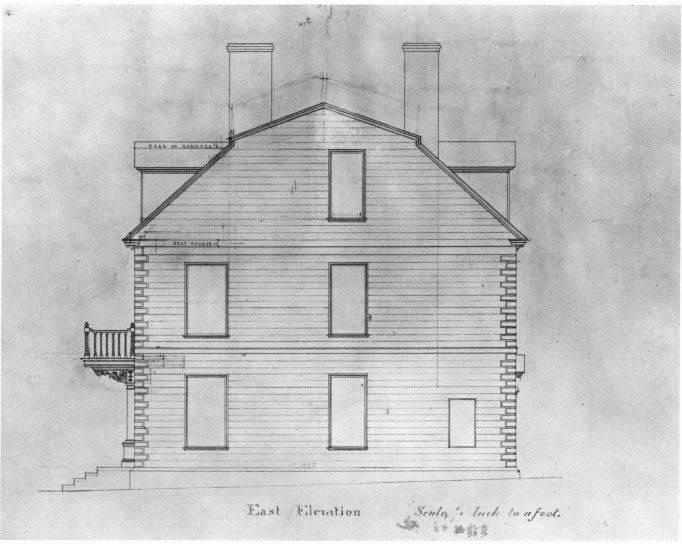
27. East elevation, Hancock house. Measured drawing (1863) by John Hubbard Sturgis. Courtesy Society for the Preservation of New England Antiquities.
Following the death of Thomas Hancock in 1764, the property (which included much of the south slope of Beacon Hill) was inherited by his nephew John, first signer of the Declaration of Independence, who lived there as the first governor of Massachusetts. With his death in 1793, financial difficulties concerning the house began. For, despite his popularity and eminence, John Hancock was notorious (particularly to those in contact with him during his tenure as treasurer of Harvard College) as incompetent and inattentive, if not totally dishonest, in financial matters.70 In 1795 the Commonwealth of Massachusetts purchased the pasture just to the east of the house for the site of Charles Bulfinch’s new State House, further reducing the acreage, and by 1863 the estate had fallen onto hard times and taxes were overdue. Plans to extend Hancock Street south from Cambridge Street to Beacon, directly through the site of the house, strongly suggested to many the demolition of the building. Speaking in favor of saving (or relocating) the Hancock House, Arthur Gilman may also have recommended that measured drawings be made when demolition was inescapable. He may well have suggested his young associate John Sturgis for the job.71
Sturgis made measured drawings of the house and at the auction purchased the staircase. His plans for using it were uncertain, and it was put into storage in Boston. It was still there when in 1866 he sailed for England to remain for four years, leaving his young partner Charles Brigham in charge of his Boston architectural office. But on April 5, 1869, Brigham wrote to England:
Hancock staircase—I have advertised it for sale but I cannot answer your question as to its worth inasmuch as it would fetch but little, but for its value historically. Mr. Poland will have to move from his shop on the 15th to make way for the new P. O. Building (which by the way Bryant has to superintend) and we shall have to remove the staircase unless I get a purchaser previous—I shall demand $150—please write me at once of your approval if you think it right—I enclose a drawing of plan of it.72
Not hearing from his partner, however, Brigham made the decision to sell the staircase, writing again on May 26:
I did not have time to mention the subject of the Hancock staircase but as the deed was done and could not be retracted I deferred till now to reply to your regrets or rather expressions of fear that I had sold it. I did understand that you would like to dispose of it but had there been time to have received more definite instructions from you I should have delayed any actions till then. As I intimated in my letter of April 5th the shop where it was stored was not torn down until about May 1st and I waited till the last moment. I had had an offer from Mr. Greeley Curtis of $50 and of course refused it. I had gone so far as to have sent a portion of it down to Broad Street where your furniture is stored and was in search of a place to store the more bulky parts which could not be got up to the attic on account of their weight and size when I received a note from him saying that he would give $125 which I at once accepted. If I could have stored it all together I should have let it remain till further news from you, but the only place where I could find a shelter for it was under an open shed. The carpenters are driven to small quarters and I feared that the cost of storage would be too much. I regret to have misunderstood you, but I think it has gone into the possession of those who will appreciate it. Mr Curtis is having it put up in his house at Manchester now building. He could probably have been induced to give more for it but that he had already got his stairs half built before he knew this was for sale which excuses his first paltry offer.73
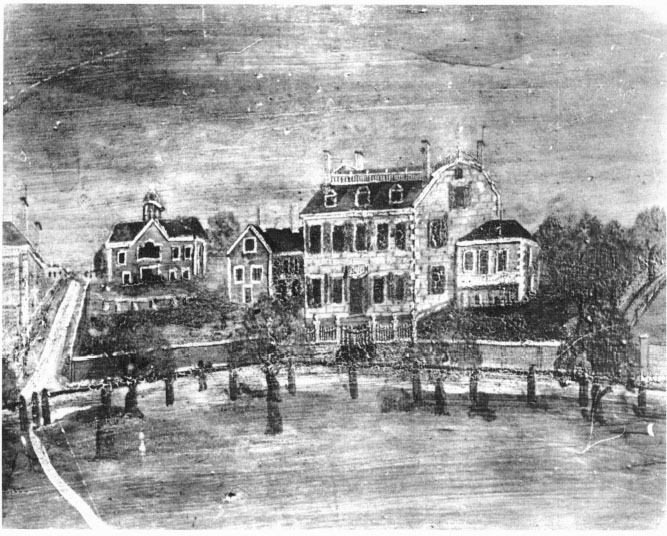
32. Hancock house. Detail of fireboard painting of Park Street Church, Boston (c. 1812). Oil on panel 35¾″ × 49½″. Painted for Joseph Allen. Courtesy Bostonian Society.
A picture thus emerges of Sturgis, whatever his reasons, being reluctant to part with the unused staircase. Had he known its location, he would have been even less enthused, for the great house at Manchester-by-the-Sea, of stone, with Flemish gables, was designed by Greeley Curtis (an enthusiastic amateur architect) and Henry Van Brunt of the Boston firm of Ware and Van Brunt.74 Spectacular in siting, high above the ocean, and with an impressive exterior, the house was constricted and fragmented on the interior during the first building campaign of 1869. Because the staircase in the house was already half built, that from the Hancock House was badly cut up and reversed in run in order to fit the existing space (Fig. 33).75 Brigham himself could hardly have been pleased, for he had unwittingly disposed of his senior partner’s property, and worse, Van Brunt (no friend of Brigham’s) would have the credit for utilizing the staircase, no matter how he had botched the job of installation!76
So the Hancock House was demolished and the staircase saved, but more important even than its preservation were the measured drawings which Sturgis made from the staircase in situ. Recently it has been suggested that measured drawings should in fact be termed measuring drawings, for they differ from designs or plans which an architect makes for a projected new building in that they are created after the fact of the edifice.77 A measured drawing is done to scale from an existing structure and requires a rather complex set of calculations with tedious attention to detail. The central point of consideration for any measured drawing is why it is needed in the first place. In the case of the Hancock House, the demolition controversy and historical importance of the structure provided the impetus which had heretofore been missing in America, a young and growing country with few ancient buildings to measure. So until the mid-nineteenth century when a new consciousness of the importance of our Colonial architecture began to become apparent, measured drawings had not really been needed.
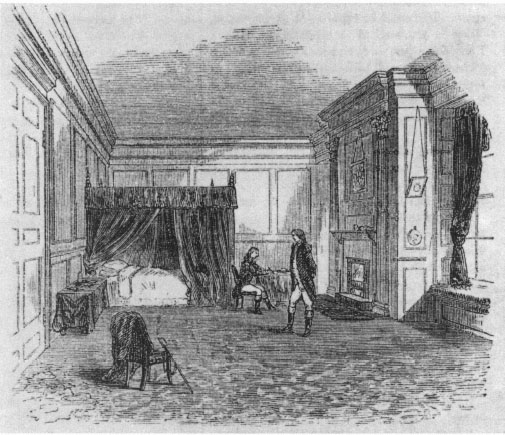
34. The Washington Room in the Hancock house. Wood engraving from Ballou’s Pictorial Drawing-Room Companion (March 26, 1859). Courtesy Bostonian Society.
Some idea of the state of the art emerges if we consider the number of architects travelling up and down the east coast sketching Colonial buildings during the 1870’s78 and the numerous books on Colonial architecture published following the 1876 Centennial Exhibition in Philadelphia. Sketches like those of Arthur Little, New England Interiors (Boston, 1878), or Edwin Whitefield, The Homes of Our Forefathers in Boston, Old England and Boston, New England (Boston, 1889), were picturesque endeavors but not measured drawings from which specific details could be reproduced.
Therefore, in 1863, since few American architects were familiar with the process of measured drawings, John Sturgis, who had been trained in England during the 1850’s, was an obvious choice to make those of the Hancock House. He had been the pupil of James K. Colling, renowned as one of England’s finest draughtsmen, who had published numbers of books of measured drawings.79 Although measured drawings were uncommon in America, such was not the case in England. There, within the heightening fever of the Gothic Revival, numerous architects, armed with sketch pads and yardsticks, were examining the moldering ruins of countless country churches and Gothic halls, sadly in need of restoration.80 The middle decades of the nineteenth century had brought a realization of the condition of the national architectural heritage in England, leading ultimately to the founding of the Society for the Protection of Ancient Buildings in 1876 by William Morris.81
A product of this tradition, John Sturgis had returned to Boston only in 1861, less than two years before the demolition of the Hancock House. During the next two decades he was to continue as the prime purveyor of English architectural taste in Boston.82 He imported not only theory and design but specific elements of buildings: terra cotta, tile, wrought iron, and woodwork from London to build great houses for the Boston aristocracy of the late nineteenth century, much as Thomas Hancock had done for his own house over a century before.
By the autumn of 1870, when John Sturgis again returned to Boston to win the competition for the Museum of Fine Arts on Copley Square, the Hancock House staircase was installed at Manchester-by-the-Sea. But Sturgis’ measured drawings remained in his papers. Of special interest is his drawing of the staircase (Fig. 31), which he later would use as the basis for stairs in two houses in Cambridge—early examples of Colonial Revival design.
An overall relationship to the Hancock House is apparent in the exteriors of both the Edward W. Hooper house (1872) at 25 Reservoir Street (Fig. 35) and the Arthur Astor Carey house (1882) at 28 Fayerweather Street (Fig. 37), only a block away.83 Like their model, both houses have gambrel roofs, are essentially rectangular, and are bisected by a central hall with staircase (Figs. 36, 38). In each case, however, the architect has subdivided the hall (which no longer completely bisects the depth of the house), has moved the stair from its position opposite the entrance to one adjacent to it on the main facade, and has added a fireplace to create a Queen Anne Revival living hall.84 The Hooper House, which is earlier by ten years, reflects much exterior detail reminiscent of the 1870’s, freely combined with elements borrowed from the Hancock House. For example, the two over two windows, shed dormers, and mansarded wing suggest its date. Revealed construction with a band of stickwork forms the belt course between the floors and continues uninterrupted across the two-story bay window. The ornate wooden parapets are identical to those in stone then being used by the architect in several other houses in the Back Bay.85 Although the elevation is symmetrical and the appearance of the gambrel roof notable, the composition is treated freely and creatively, one of the most interesting characteristics of early Colonial Revival design.
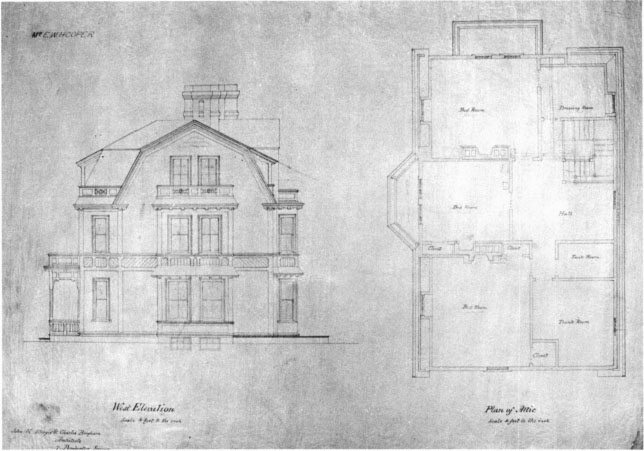
35. West elevation and plan of attic, E. W. Hooper house (1872), 25 Reservoir Street, Cambridge, by Sturgis and Brigham. Courtesy Mr. Charles Eliot.
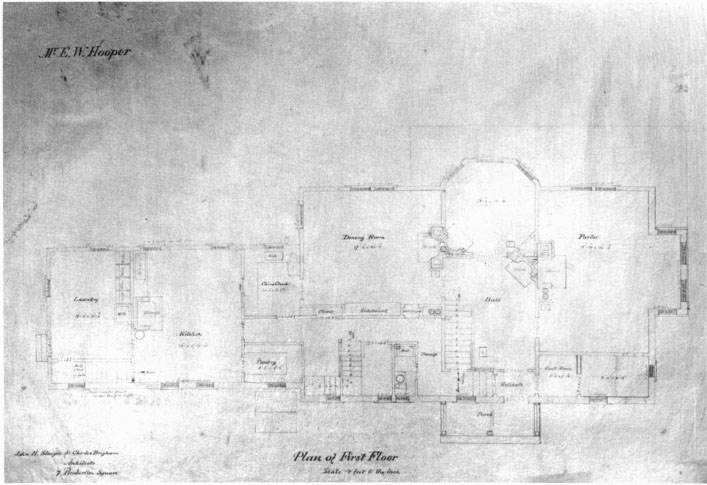
36. Plan of ground floor, E. W. Hooper house (1872), 25 Reservoir Street, Cambridge, by Sturgis and Brigham. Courtesy Mr. Charles Eliot.
The later Carey House (1882) is more classical in its ornament, much closer to the original Hancock House, but the architect now manipulates the frame of the building more freely (Fig. 37). The dormer windows, dentilled entrance bay with balcony on carved brackets, and the scrolled pediment above the central window are very specific ornamental components of the eighteenth-century model. To these Sturgis adds a round arched window derived from that on the Hancock House staircase, but now penetrating the main facade adjacent to the entrance. The two-story bay windows seen on the Hooper House, characteristic elements of American post-Civil War design, do not appear in the later Carey House. Instead a studied “colonializing” of the frame has been introduced with a lean-to at the rear and an overhang in the end gable as well, both features associated with seventeenth-century design.
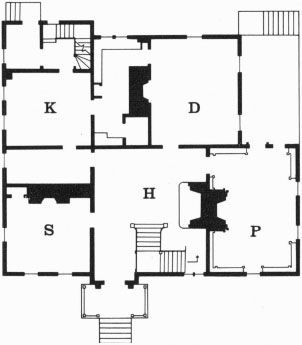
38. Plan of A. A. Carey house (1882), 28 Fayerweather Street, Cambridge, by Sturgis and Brigham. Measured drawing by Susan Maycock Vogel. Courtesy Cambridge Historical Commission.
The interior detailing of both houses is creatively varied but also closely derived from the Hancock House drawings. Each house has a great panelled chimney breast in the parlor based on that in the Washington bedroom of the Hancock House (Figs. 34, 39, 40). The newel post of the Carey House stair (Fig. 41) is a near copy of its model (Fig. 31), while the panelled shutters in the bedroom are additional colonializing elements (Fig. 42).
Certainly, then, in the work of John Sturgis the measured drawings of the Hancock House can be said to have influenced the course of design for new construction in the first quarter-century after the demolition of that great Georgian mansion. But in fact, by 1888, the year of Sturgis’ death, the momentum of influence of the Hancock House was just beginning to accelerate. In the last decade of the nineteenth century it was transformed into far more than a destroyed monument—it had become an institution, one which was to be copied over and over again with varying degrees of faithfulness to the original, and used not only as a model for houses but for public buildings as well.
Only in the years following the Centennial Exposition in Philadelphia in 1876 had the importance of American Colonial architecture begun to be generally recognized. Robert Swain Peabody (1845–1917), a contemporary of Sturgis, who had been born in New Bedford, had already surfaced as its spokesman, notwithstanding his training at the Ecole des Beaux-Arts in Paris in 1868, two years after graduating from Harvard College.86 It was he who was to carry forward the Hancock House legend after Sturgis’ death in 1888. In 1877, writing in the American Architect and Building News, he stated his affinity for Colonial design:
There is no revival so little of an affectation on our soil, as that of the beautiful work of Colonial days. Its quiet dignity and quaintness, its cosiness and elegance, always attract us. It is our legitimate field for imitation, and we have much of it to study right in our own neighborhood. In fact, anyone who in summer drives over the ancient turnpike from Hingham to Plymouth will not only pass through a beautiful country full of old homesteads, but will find the sun-flowers still nodding behind the gambrel roofed houses that line the road through Queen Anne’s corner.87
Twelve years later Peabody’s admiration for the Hingham area was rewarded when he received the commission for a Parish House for the Old Ship Church (Fig. 43), even then a seventeenth-century sacred cow among Colonial structures. The resulting design, linked physically to the ancient meetinghouse on the opposite promontory through the umbilical cord of an underground heating system engineered to run under Main Street, seems to have served as an interim exercise in 1889 for the Massachusetts State Building which he was to erect in Chicago three years later. It was closely based on the features of both the Old Ship Church and the Hancock House
The first Parish House was necessarily a rectangle housing an oblong auditorium, but Peabody’s perspective drawing, now in the collections of the Massachusetts Historical Society, appears centralized, reflecting the original seventeenth-century plan of the Old Ship Church. The elevation, dominated by two great intersecting gambrel roofs, is marked at their crossing with a cupola. The double slope of the roof system, the Palladian window, balconied porch, and classical detail clearly evoke the Hancock House, while the swelling profile and cupola echo the famed truss system of the meetinghouse. It was a brilliant and typically free nineteenth-century version of a parish house to “match” the church and appears to have been directly connected to the design which the architect produced three years later for the World’s Columbian Exposition in Chicago (Fig. 44).
Discussing the Massachusetts State Building at the time of the Chicago Exposition, Peabody is specific in expressing his debt to the Hancock House:
Casting about for models that might fitly recall New England surroundings . . . the Old State House and the Hancock Mansion which once stood on Beacon Hill, seemed to offer the best possible types. This Hancock house, with its terraced gardens, was the most picturesque as well as the most architectural of the two buildings. For these reasons it was selected as a model. . . . The valuable quality in the design of the original Hancock house was the air of aristocratic distinction and reserve and dignity that it bore, without losing a homelike and comfortable appearance.88
So by 1893 the Hancock House had moved from its role as a model for houses to a symbolic structure considered also appropriate for public buildings.
The saga of the Hancock House is thus prototypical in historic preservation. It would almost appear that circumstances conspired to maximize its stature after 1863. The immense controversy attending the demolition (not to mention the artifacts distributed through the auction) and the publicity naturally associated with the fame of the owners gained initial attention. The prominent location on Beacon Street adjacent to Bulfinch’s State House (now memorialized with a bronze plaque) kept the site continually in the public eye, and the unique circumstance of Sturgis’ measured drawings and their utilization in his own work drew continuing attention to the design. But those elements were only a prelude to the selection of the Hancock House as model for Pcabody’s Massachusetts State Building at the World’s Columbian Exposition in Chicago in 1893, for this later structure, seen repeatedly by visitors from all over the world, was more responsible than any other factor for making it the sine qua non as a model for late nineteenth-century buildings in America: the archetype of Colonial Revival design.

 MARGARET HENDERSON FLOYD
MARGARET HENDERSON FLOYD 
